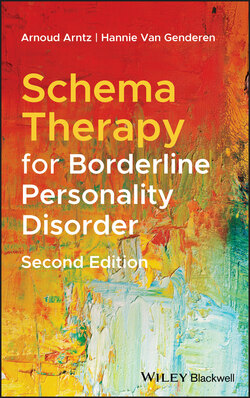Читать книгу Schema Therapy for Borderline Personality Disorder - Hannie van Genderen - Страница 12
Introduction
ОглавлениеUntil recently, patients with borderline personality disorder (BPD) were known as particularly difficult patients. They were viewed as patients who either could not be helped by therapy or, in the best‐case scenario, showed low success rates to treatment. Meanwhile, their demands on both medical and mental health care are great and their dropout rates from treatment programs are high.
In this book we describe a treatment for patients with BPD, which, in most cases, leads to recovery from this disorder or substantial clinical improvement. Schema therapy (ST) not only leads to a reduction in BPD symptoms, but also to lasting changes in the patient's personality.
In Chapter 1, BPD is defined and described, followed by a discussion of the development of this disorder.
Chapter 2 gives an explanation of ST for BPD, developed by Jeffrey Young. The treatment is based on the schema mode model. The different schema modes for patients with BPD are described in this chapter.
In Chapter 3 we explain the aims and different phases of the therapy.
Chapters 4–8 discuss different treatment methods and techniques. Chapter 4 involves seeing the therapeutic relationship as an instrument of change. Also the essential concept of “limited reparenting,” a central point of ST, is discussed at length.
Chapter 5 describes experiential techniques that use experiencing to bring about change. These techniques are: imagery rescripting; role playing; the two‐or‐more‐chair technique; and experiencing and expressing feelings.
The cognitive techniques used in this book are described and explained in Chapter 6. As there is a great deal of literature about these techniques, they are only briefly defined. This is also the case for the behavioral techniques described in Chapter 7.
Chapter 8 deals with a number of specific therapeutic methods and techniques. While these are not relevant for all BPD patients, they can be important and useful for specific patients and applications.
Chapter 9 explains which techniques are the most appropriate to each schema mode. The art of addressing different modes in a single session is also discussed in this chapter.
The latest developments in the field of ST are explained in Chapter 10. In particular, Group‐ST, and ST with couples where one of the two partners has BPD, are discussed. We also briefly discuss the application of ST in day treatment and inpatient settings, the use of nonverbal therapies as adjunct to ST, and the application of ST for children and youths, and older people.
Chapter 11 deals with the final phase of therapy during which the patient no longer has BPD, but perhaps retains some of the personality characteristics and/or coping strategies, which could stand in the way of further positive changes.
Chapter 12 contains the summary and conclusion.
Considering that a large percentage of BPD patients are female, the authors refer to the patient in the feminine form. Although many therapists are female, for the sake of clarity the authors refer to the therapist using the masculine form.
